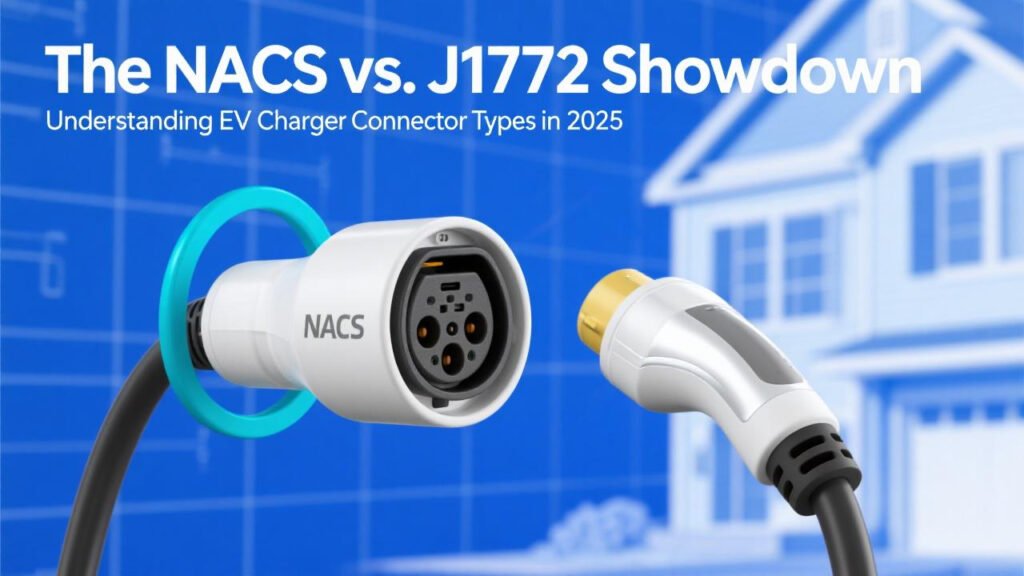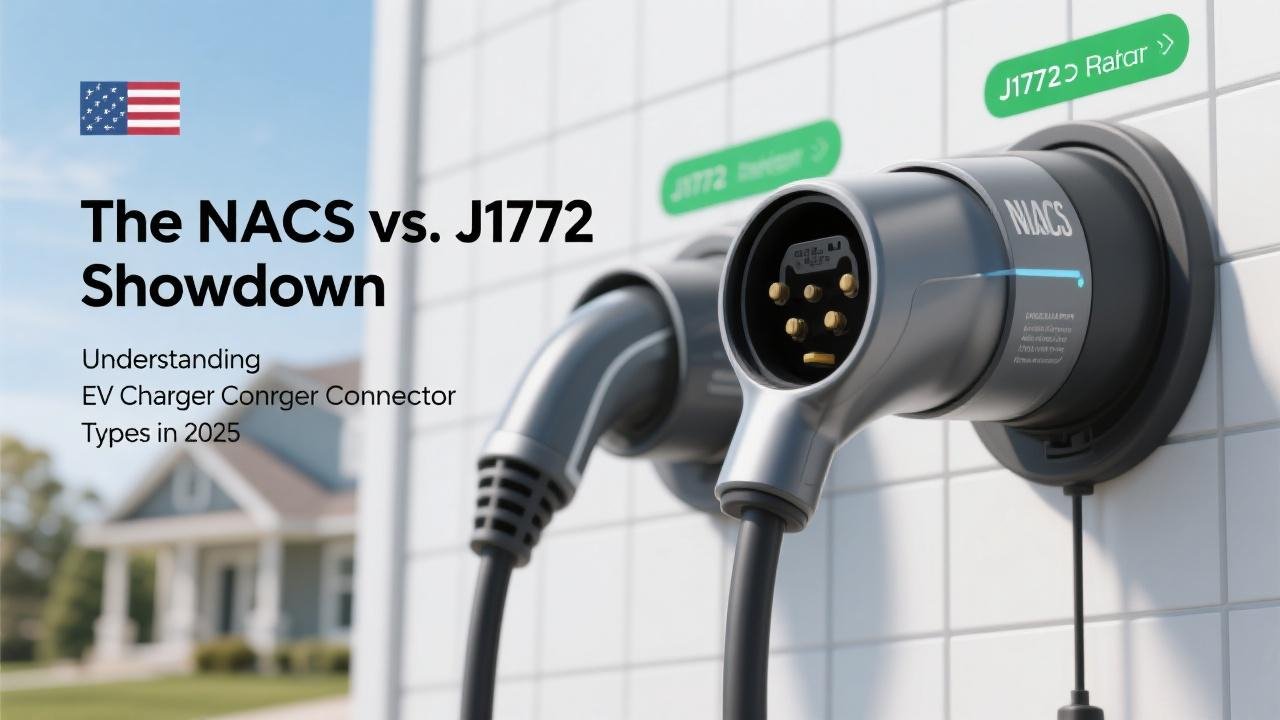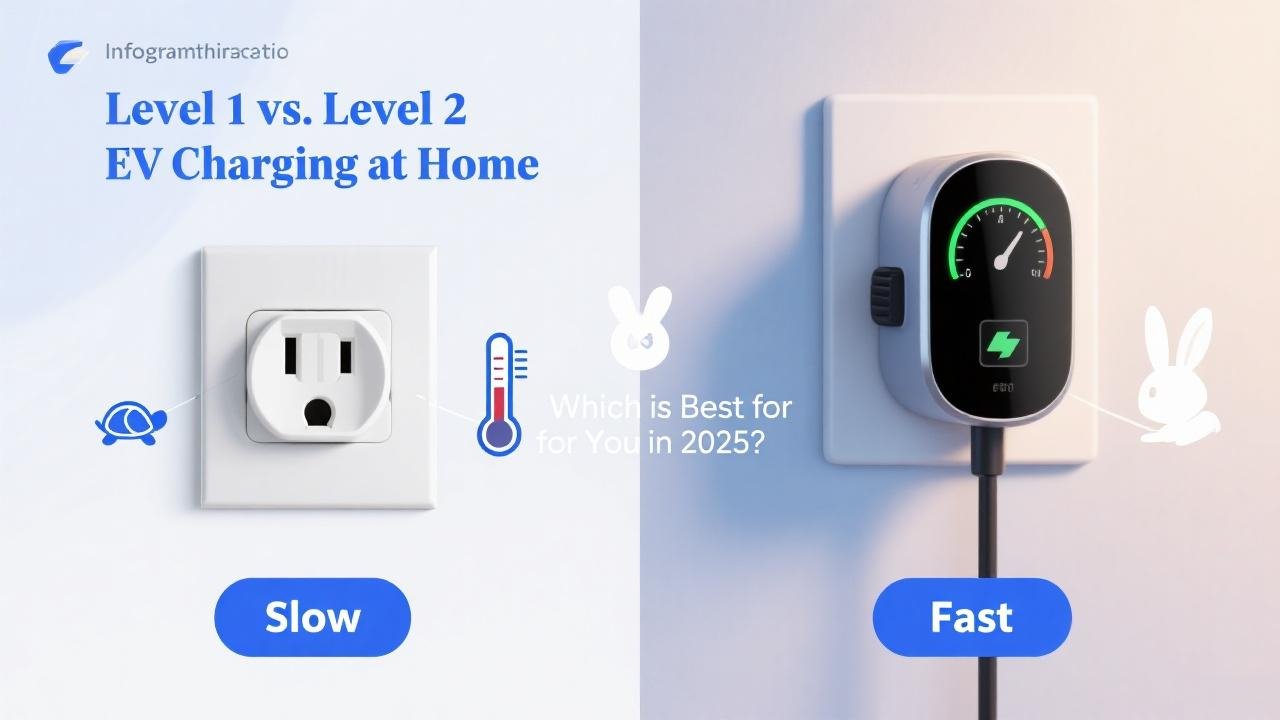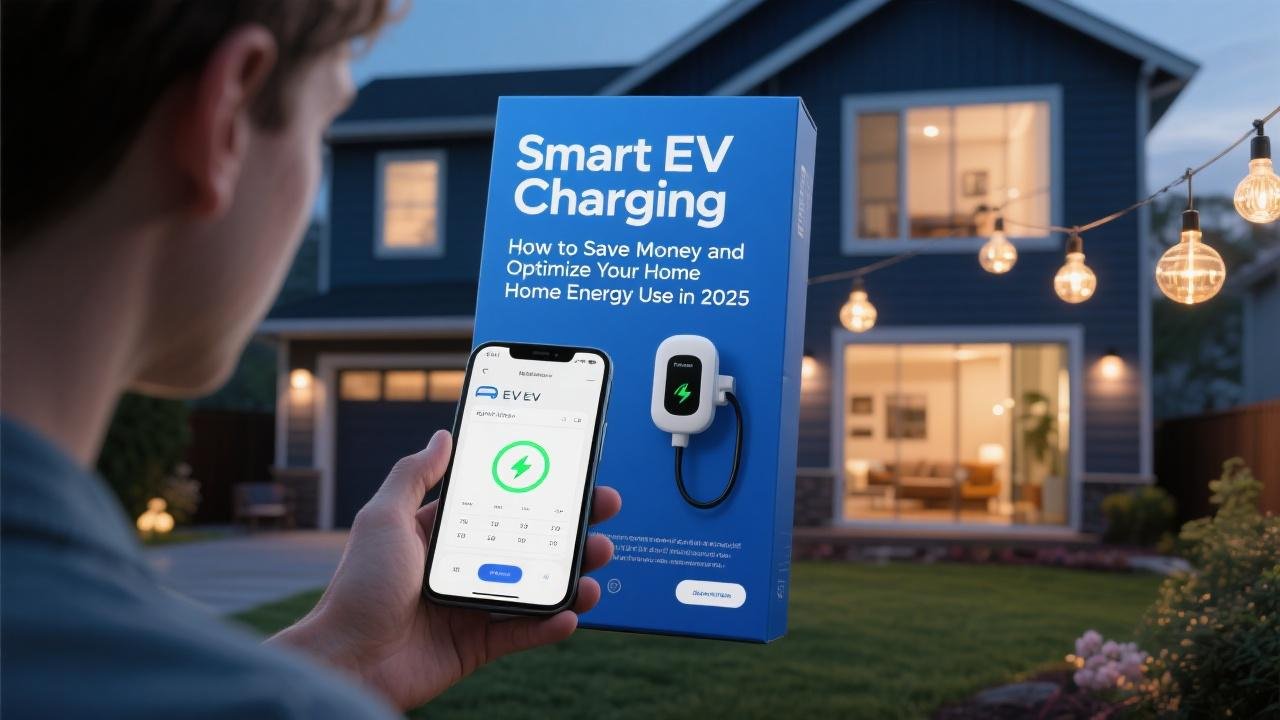The Plug That Powers Your EV – A Changing Standard
You’ve chosen your electric vehicle (EV), and now you’re looking at home charging solutions. One of the fundamental, yet sometimes confusing, aspects you’ll encounter is the charging connector – the plug that physically connects your car to the charger. For years, the North American EV market has seen two primary Level 2 AC charging connector types: the J1772, used by most non-Tesla EVs, and Tesla’s proprietary connector, now known as NACS (North American Charging Standard).
However, 2025 marks a pivotal moment in the EV charging landscape. A significant shift is underway, with many automakers announcing plans to adopt the NACS standard. This guide will explain the differences between NACS and J1772, the implications of this transition, and how to choose a home charger that keeps you future-proofed.
The Two Main Players (Historically):
SAE J1772 (Type 1 Connector):
- Who Uses It: This has been the standard Level 1 and Level 2 AC charging connector for all non-Tesla electric vehicles sold in North America for many years. This includes brands like Chevrolet, Ford, BMW, Nissan, Hyundai, Kia, Volkswagen, Rivian, Lucid, etc.
- Design: A round connector with five pins.
- Ubiquity: Found on the vast majority of public Level 2 charging stations across North America.
NACS (North American Charging Standard) / Tesla Connector:
- Who Uses It: Developed by Tesla for its vehicles, this connector handles both AC Level 1 & 2 charging and DC fast charging (Supercharging) for Tesla cars through a single, more compact port.
- Design: A smaller, sleeker proprietary connector.
- Tesla’s Network: Tesla vehicles primarily use this connector at Tesla’s extensive Supercharger network and Tesla Wall Connectors for home charging.
The Great Connector Shift of 2025 and Beyond:
Starting in late 2023 and accelerating through 2024, a major industry shift began:
* Ford and GM Lead the Charge: Ford was the first major automaker to announce it would adopt Tesla’s NACS connector for its future EVs (starting in 2025 models) and provide NACS adapters for existing CCS (Combined Charging System – which uses the J1772 for AC charging) vehicles to access Tesla Superchargers. General Motors quickly followed suit.
* A Cascade of Adoptions: Since then, numerous other automakers, including Rivian, Volvo, Polestar, Mercedes-Benz, Nissan, Honda, Hyundai, Kia, BMW, Mini, Rolls-Royce, Volkswagen, Audi, and Porsche have announced plans to switch to the NACS port for their North American EVs, generally starting with 2025 or 2026 model years.
* Charging Network Support: Major public charging networks like ChargePoint, EVgo, and Electrify America are also adding NACS connectors to their stations to accommodate this shift.
Why the Shift to NACS?
* Simpler, More Compact Design: The NACS connector is generally considered smaller and easier to handle than the J1772.
* Access to Tesla’s Supercharger Network: This is a huge driver. Adopting NACS gives non-Tesla EVs access to Tesla’s highly reliable and widespread Supercharger network for DC fast charging (though access terms and adapter requirements are still being finalized for many).
* Potential for a Unified Standard: The industry is moving towards a single charging standard for North America, which simplifies things for consumers and infrastructure development. SAE International has announced it will standardize the NACS connector as SAE J3400.

What This Means for EV Owners and Home Charger Choices in 2025:
This transition period can create some confusion, but here’s how to navigate it for home charging:
- If You Own a Tesla:
- A Tesla Wall Connector (NACS) is a natural choice for home charging.
- You can also use a J1772 charger with the J1772-to-NACS adapter that typically comes with your Tesla.
- If You Own a Non-Tesla EV with a J1772 Port (Most current models):
- A J1772 Level 2 home charger is your standard option.
- As NACS becomes more prevalent in public charging, you may want an NACS-to-J1772 adapter for on-the-go flexibility if you encounter NACS-only public chargers.
- If You Are Buying a New 2025+ EV:
- Check the Port! Confirm whether your specific model will come with a J1772 port or an NACS port. This is crucial for selecting your home charger. Many 2025 models from adopting automakers will begin featuring the NACS port directly.
- Future-Proofing Your Home Charger Purchase:
- Tesla Universal Wall Connector: This charger is an excellent future-proof option as it features a built-in adapter that allows it to connect to both NACS and J1772 vehicles seamlessly. This is ideal if you have a mixed-EV household or plan to switch vehicle brands in the future.
- Chargers with Swappable Cables/Adapters: Some charger manufacturers may offer options to swap cables or use robust adapters as the market standardizes.
- Consider a J1772 Charger with an NACS Adapter: If you buy a J1772 charger now, you can purchase a quality NACS-to-J1772 adapter if your next EV has an NACS port. However, a native NACS solution or a universal connector is often preferred for simplicity.
Adapters: A Temporary or Long-Term Solution?
Adapters play a key role during this transition:
* J1772-to-NACS Adapter: Allows Tesla vehicles to use J1772 chargers. Commonly provided by Tesla.
* NACS-to-J1772 Adapter: Will allow J1772 vehicles to use NACS chargers (including some Superchargers, once access is enabled). These are becoming more available from third-party manufacturers and automakers. Amphenol has introduced a UL 2252 safety-certified NACS-to-CCS1 adapter.
While adapters offer flexibility, a native connector matching your vehicle’s port is generally the most convenient and robust solution for frequent home charging.
Navigating the EV Plug Evolution
The EV charging connector landscape is undergoing a significant and positive evolution towards a more unified standard in North America with the adoption of NACS (J3400). For homeowners installing EV chargers in 2025, this means paying close attention to the charging port on your current or future EV.
Opting for a charger with a native NACS connector if your new EV has one, or choosing a versatile solution like the Tesla Universal Wall Connector, can provide the best long-term convenience and future-proofing. While J1772 chargers remain relevant for many existing EVs, the trend clearly points towards NACS as the dominant standard moving forward. Consulting with your EV manufacturer and a qualified electrician will help you select the ideal home charging setup for your electric journey.



